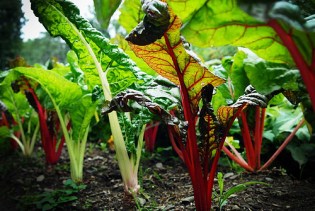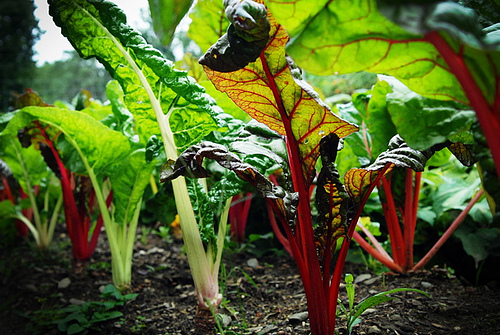This post is part of Protein Angst, a series on the environmental and nutritional complexities of high-protein foods. Our goal is to publish a range of perspectives on these very heated topics. Add your feedback and story suggestions here.

Most people erroneously think proper nutrition is mainly about vitamins and minerals, but there is a whole other world within the plant kingdom: phytonutrients. Photo: MJM
By and large, the most environmentally friendly dietary decision one can make is to eat less animal protein (see deforestation, water pollution, and greenhouse-gas emissions, etc). But for many, the notion of eschewing — or significantly cutting back on — meat, eggs, and dairy brings up nutritional concerns. As I see it, not only are those concerns usually unfounded, they should pale in comparison to the question of getting enough plant-based foods.
Let’s begin with protein. Here’s something most people don’t know: Barring oils and some fruits, there is protein in almost every food. Yes, that includes broccoli, spinach, and potatoes. Most people are surprised to learn that a cup of cooked oatmeal offers as much protein as an egg, and an almond butter sandwich on whole grain bread provides 15 grams of protein (around a quarter of a day’s recommendation for a 160-pound male). To determine your protein requirement, divide your weight in pounds by 2.2, and then multiply that number by 0.8. You can, of course, surpass that figure.
You’ll hear lots of talk about “complete” versus “incomplete” proteins, but I consider that concept irrelevant and outdated. It goes something like this: Complete proteins contain all essential amino acids (“essential” meaning our bodies don’t produce them, so we need to get them from food); incomplete ones have very low amounts of — or lack — an essential amino acid. Meat, poultry, and fish are complete proteins. While there are some plant-based complete proteins like amaranth, buckwheat, quinoa, and soy, the vast majority is “incomplete.”
Incomplete proteins are only a concern if someone eats exclusively from one food group (i.e. nothing but potatoes, or nothing but bread) for extended periods of time. Luckily, eating from more than one food group is not only possible, it’s what most of us crave. You would be hard pressed to find someone who won’t naturally, throughout the course of the day, consume food from more than one food group. Even if you subsist on nothing but peanut butter sandwiches for a week you are getting all the essential amino acids (legumes and grains are two different food groups, and it just so happens that the essential amino acids that are low in bread are high in legumes, and vice versa).
Frances Moore Lappé, who popularized the idea of “protein combining” in the first edition of her book Diet For A Small Planet (1971), retracted that theory in the book’s 1981 edition:
In 1971 I stressed protein complementarity because I assumed that the only way to get enough protein … was to create a protein as usable by the body as animal protein. In combating the myth that meat is the only way to get high-quality protein, I reinforced another myth. I gave the impression that in order to get enough protein without meat, considerable care was needed in choosing foods. Actually, it is much easier than I thought.
With three important exceptions, there is little danger of protein deficiency in a plant food diet. The exceptions are diets very heavily dependent on [1] fruit or on [2] some tubers, such as sweet potatoes or cassava, or on [3] junk food (refined flours, sugars, and fat). Fortunately, relatively few people in the world try to survive on diets in which these foods are virtually the sole source of calories. In all other diets, if people are getting enough calories, they are virtually certain of getting enough protein. [Emphasis mine.]
Even the National Institutes of Health (a conservative group when it comes to nutrition issues) supports Lappé’s point. On their website, they say that “protein foods are no longer described as being ‘complete proteins’ or ‘incomplete proteins.'” So, please, let’s put this issue to rest.
The other group of plant protein critics are those who believe its quality to be low. They usually reference the “Protein Digestibility Corrected Amino Acid Score,” which is a tool for measuring protein digestibility in humans. A quick glance at the list and you may conclude that plant-based protein sources are indeed inferior to milk, eggs, and beef. After all, the only plant-based food with a “perfect” score of 1.0 is soy protein, while chickpeas get a 0.78 and vegetables get a 0.73. However, as with the “complete vs. incomplete protein” argument, as long as you eat different types of plant-based foods throughout the course of the day, they will complement each other and form a “perfect” protein score.
As a nutrition professional, I get very frustrated by the protein-centric framework that inevitably comes up when plant-based eating is discussed, particularly because the average American consumes sufficient protein, but nowhere near the daily recommended amounts of fiber and several important minerals, like magnesium. Low intakes of both are associated with higher risks of chronic disease. And, here’s an indisputable fact: No matter how humane, local, pastured, or organic your steak or chicken is, it does not offer fiber or significant levels of magnesium. Vegetarian sources of protein, meanwhile (nuts, seeds, beans, whole grains, pseudograins, and vegetables) are good — and in some cases, excellent — sources of both.
Never heard of “pseudograins” before? Though cooked and consumed like grains, amaranth, buckwheat, millet, quinoa, and wild rice are seeds.
Most people erroneously think proper nutrition is mainly about vitamins and minerals, but there is a whole other world within the plant kingdom: phytonutrients. These chemical compounds, which we are learning more about with each passing year, are not present in animal products. But, they occur naturally in plant-based foods. These compounds give fruits, vegetables, beans, and grains their particular colors and aromas. Added bonus: They also confer their own sets of health benefits.
Quercetin — a phytonutrient found in apple peels, onions, and tea — is believed to improve blood cholesterol levels and help lower the risk of some cancers. Research on isothiocyanates, abundant in dark leafy greens, has also demonstrated their capacity to help protect against chronic disease. Other popular phytonutrients include lignans (in flax and sesame seeds) and phenolic acids (peanuts, walnuts). Mind you, there are over 170 phytochemicals in a single orange.
Phytonutrients are sensitive to processing, which is why they are most abundant in whole, plant-based foods (think a diced apple in a salad rather than a glass of commercial apple juice). Most importantly, phytonutrients are relatively new to the field of nutrition, so there are many still yet to be discovered and studied.
As you can see, plant-based foods are more than just meat and protein substitutes. We must stop treating meat as the nutritional golden standard, especially since so-called “alternatives” offer an array of health-promoting compounds. The United States is in the grips of a nutritional deficit disorder that would be drastically minimized if we all started eating less meat and more plants.
One final note: Vitamin B12 is not present in plant-based foods. Fortunately, it can easily be fortified in foods and supplemented. The unique biochemical makeup of plant-based foods, however, cannot be replicated in a pill. Not only are there thousands of phytonutrients, but research has shown they need to operate within their original food matrix to be efficient (aka, isolate them and they get separation anxiety and can’t function right).
So by all means, cut back on animal protein and eat more whole, plant-based foods — it’s good for both bodies of water and human bodies!




